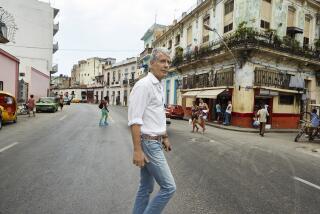Book review: ‘The Turquoise Ledge’ by Leslie Marmon Silko
The Turquoise Ledge
Leslie Marmon Silko
Viking: 319 pp., $25.95
Leslie Marmon Silko writes in the language of the spirit — reading her words as she constructs a portrait of herself for this memoir is not only like being inside her head, it is like eavesdropping on her silent conversations with her gods.
Silko was born in 1948 in Albuquerque and grew up on the edge of the Laguna Pueblo reservation in north central New Mexico. She is part Laguna Pueblo, part Cherokee, part Mexican and part Anglo. . Her first novel, “Ceremony,” was published in 1977 and has since become one of the Native American novels most often taught in schools and universities. In 1981, she was awarded a MacArthur Foundation fellowship, or “genius grant.” She also wrote two other novels and several poetry and short-story collections, many of them telling stories from her life and the lives of her ancestors.
In this memoir, Silko walks on the trails and in the sandy arroyos near her home in the Tucson Mountains. She picks up pieces of turquoise formed from the effects of weathering, volcanic disturbances and water on surface minerals. She imagines that she is walking on a large turquoise ledge not far beneath the surface of the ground, covered by palo verde trees, mesquite, saguaro and prickly pear. She picks up grinding stones and imagines the songs sung by the women who used them to grind corn and other seeds.
“At a certain walking speed, my eyes received light images from a parallel plane. Parallel planes or worlds may be visible briefly at certain points in this world from time to time.” Walking allows her to drop into this other state, “a less self-conscious state where I could better perceive the delicacy of the light and the dawn moisture in the breeze.” From this state of mind come memories and some revelations.
She thinks about things she has lost (“What is it about us human beings that we can’t let go of lost things?”) and about people in her past. She thinks about the ghosts she has seen and what is left after the people one loves pass on: “a few days or a week after they go, they manifest their loving energy: the wind chimes twinkle in the twilight though there is no breeze; the chimney of the oil lantern rattles by itself; the electric fan blades make an unusual sound — the realm of the spirit beings and the ancestors contact us from time to time.”
She thinks about the importance of animals in her life — when she was young, she writes, she was uncomfortable around humans. She felt “unease and anxiety to please everyone” and so preferred to be alone. In this separation, Silko found writing easier than speaking. She grew up comfortable with the idea of telling stories as a way of communicating. The Laguna notion of story, she writes, “covers the widest possible range: historical accounts, village gossip, sacred migration stories, hummah-hah stories that included Coyote and the other animals and supernatural beings.... Stories are valuable repositories for details and information of use to future generations.”
This tradition clearly had a profound effect on Silko’s writing style. While the written word often carries a trail of nostalgia, of digested experience and longing for the past, Silko’s echoing tone reverberates into the future. No matter how much she writes of ancestors and geography, these pages echo forward, not back. Sentence by sentence, a reader is given an enormous amount of useful information about how to get the most out of life, beginning in the present moment. She has taken us down into the subconscious — like Eurydice or Castaneda — and she shows us how to behave in that subconscious: where to walk, which stones are useful, what certain cloud formations betoken, how to encounter snakes, what the petroglyphs mean.
And then we surface, in the present: “This morning was too dry for rain,” she writes in her simplest, clearest style. “And the mist from the clouds evaporated before it reached the ground; it rose and once again became clouds.”
Salter Reynolds is a Los Angeles writer.
More to Read
Sign up for our Book Club newsletter
Get the latest news, events and more from the Los Angeles Times Book Club, and help us get L.A. reading and talking.
You may occasionally receive promotional content from the Los Angeles Times.






